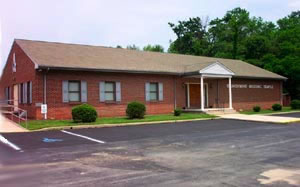Lafayette Lodge No. 14 History
On January 17, 1825, a charter was granted to Lafayette Lodge No. 14 by Grand Master, Joshua G. Brinckle, naming Josiah F. Clement, Worshipful Master, John D. Wood, Senior Warden and John Gordon, Junior Warden.
At a Special Communication of the Grand Lodge of Delaware on July 25, 1825, which was called for the purpose of making Brother Lafayette our first Past Grand Master Honorarius, the distinguished guest, his son, and secretary signed their names to the Lodge’s charter, which had been named in honor of him only six months earlier.
In 1866, Daniel McClintock became the first of ten Grand Masters to be elected from Lafayette. During his two-year term he issued warrants for Felton Lodge No. 22, Eureka Lodge No. 23, Jefferson Lodge No. 24 and revived that of Harmony Lodge No. 13.
He was followed by Grand Master Edwin J. Horner in 1868, who also served for two years. Grand Master Horner laid the cornerstone of the Town Hall at Middletown and also granted the charter for both Hiram Lodge No. 23 and Armstrong Lodge No. 26.
The third Grand Master from Lafayette Lodge was Thomas Davidson, who also served two years, beginning in 1884. Grand Master Davidson, in addition to dedicating the new Lodge rooms of Union Lodge No. 7 and Harmony Lodge No. 13, also participated with his staff in the dedication of the Washington Monument, in Washington, D.C.
In 1902, Harry J. Guthrie was elected Grand Master, the fourth to be so honored from Lafayette Lodge. In addition to chartering Doric Lodge No. 30, he also attended a communication of the Grand Lodge of Pennsylvania, which commemorated the 150th Anniversary of the initiation of Brother George Washington as a Mason. The speaker at this event was Brother Theodore Roosevelt, President of the United States, who spoke on “Freemasonry and Citizenship”.
It was PGM Guthrie along with twenty-five other brethren who petitioned the Supreme Council of the Scottish Rite to open a Lodge of Perfection. In May of 1910, the authority was given and the Scottish Rite of Freemasonry was begun in Delaware. In 1911, PGM Guthrie became the first 33rd from Delaware; and in 1912 was the first Supreme Council Deputy for Delaware.
Enoch Moore was the fifth Grand Master from Lafayette Lodge in 1911. It was his privilege to dedicate the Masonic Home of Delaware on October 2, 1912, the fulfillment of a dream of the Grand Lodge of Delaware since the idea was first proposed in 1895. The twelve-acre estate, known as Highfield, on Lancaster Pike was purchased on November 29, 1911, and dedicated less than a year later with eight guests during its first year.
The sixth Grand Master from Lafayette Lodge was Harry Galbraith in 1926, who also served as Grand Tiler. It was also during his term that Past Grand Master Charles H. Callahan of Virginia was made the fifth Grand Master Honorarius of the Grand Lodge of Delaware.
Brandywine Lodge No. 33 History

The following is an excerpt from the Grand Lodge of Delaware A.F.& A.M.’s Bicentennial History dealing with Brandywine Lodge No. 33:
“Brandywine Lodge No. 33 is proud of its fellowship and achievements even though it is a relatively young lodge having been chartered on October 28, 1961.
Prior to World War II several Past Masters of Lafayette Lodge No. 14 had informally considered forming a new lodge North of Wilmington. The idea laid dormant until July, 1961 when Lafayette Lodge No. 14 forwarded a letter to the Grand Lodge requesting a dispensation to form a new lodge. After obtaining approval from the seven lodges in Wilmington, on September 12, 1961, a letter of dispensation for Brandywine Lodge U.D. was presented by Grand Master Charles E. Daniels to the lodge naming as Worshipful Master Charles E. Hughes, as Senior Warden Robert J. Duhadaway, and as Junior Warden William B. Fugate. None of the named officers were Past Masters but all had been certified to serve by the Grand Instructor.
In October of that same year Grand Master Harry Johnson presented the charter for Brandywine Lodge No. 33. Included the 52 charter members were affiliations of Masons from nine Delaware lodges and five from out of state lodges. Twenty additional members affiliated in the first year.
While under dispensation Brandywine Lodge was most fortunate to have obtained a suitable meeting place in the old clubhouse on the Worth Steel property near Claymont. Seven months later a devastating fire occurred. Brandywine Lodge accepted the offer of Granite Lodge No. 34 to use the Grange Hall in Talleyville. Only nine months later Brandywine Lodge found an opportunity to purchase from Phoenix Steel a church on Hickman Road. These Facilities were dedicated by Grand Master William Paulin early in 1964, but by the late 1970s the neighborhood around the property had deteriorated forcing the lodge to sell in 1979. Again Brandywine Lodge moved in with Granite Lodge, but this time at historic Lombardy Hall.
In 1983 the property on Foulk Road was purchased from the Delaware Department of Transportation on which to build a Masonic facility. Ground breaking occurred on October 4, 1987 and construction was started. Much of the construction was done by the members of the lodge and the needed financial assistance was obtained, not only from members of the lodge, but from Masons through the state. Working side by side for 18 months created deep friendships among the members and their families…
Since its chartering Brandywine Lodge has produced Masonic leaders including PGM James A. Pletz and PGM Charles H. Lengel, and its members have held several other Grand Lodge offices. Its members hae been active in other Masonic bodies, especially the York and Scottish Rite.
A History of Brandywine Lodge No. 33 was prepared by PM John Rayias (1998-99)…”
– Garland, Richard, and Harold Littleton. Grand Lodge of Delaware Ancient Free and Accepted Masons: Bicentennial 2006. 1. Authorhouse, 2006. 118-119. Print.